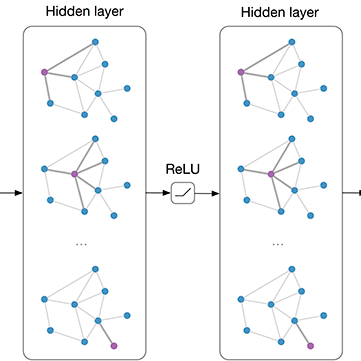Graph Convolutional Networks (GCNs) have been extensively used to classify vertices in graphs and have been shown to outperform other vertex classification methods. GCNs have been extended to graph classification tasks (GCT). In GCT, graphs with different numbers of edges and vertices belong to different classes, and one attempts to predict the graph class. GCN based GCT have mostly used pooling and attention-based models. The accuracy of existing GCT methods is still limited. We here propose a novel solution combining GCN, methods from knowledge graphs, and a new self-regularized activation function to significantly improve the accuracy of the GCN based GCT. We present quadratic GCN (QGCN) - A GCN formalism with a quadratic layer. Such a layer produces an output with fixed dimensions, independent of the graph vertex number. We applied this method to a wide range of graph classification problems, and show that when using a self regularized activation function, QGCN outperforms the state of the art methods for all graph classification tasks tested with or without external input on each graph. The code for QGCN is available at: https://github.com/Unknown-Data/QGCN .
翻译:图表革命网络(GCN)被广泛用于对图表中的脊椎进行分类,并被显示优于其他顶点分类方法。GCN被扩大到图形分类任务(GCT)。在GCT中,具有不同数量边缘和脊椎的图表属于不同类别,并试图预测图形类别。以GCN为基地的GCT大多使用集合和关注模型。现有的GCT方法的准确性仍然有限。我们在这里提出了一个新的解决方案,将GCN、知识图表中的方法和新的自我正规化启动功能结合起来,以大幅提高以GCN为基地的GCT的准确性。我们提出了四方形GCN(QCN)-带有一个四面层的GCN形式主义。这种层产生具有固定尺寸的输出,独立于图形顶点号。我们将这种方法应用于广泛的图形分类问题,并表明在使用自正规化启动功能时,QGCN将所有以外部输入方式测试的CN分类任务的艺术状态排出。在每一个图形上,可得到 MAG/NG/G/NULG的代码。





